Yellow peeling, which in cosmetology is called retinoic peeling, is a special procedure. It can replace modern creams, masks and other expensive products that help preserve youth for a long time. The article presents real reviews about retinoic peeling, photos before and after the procedure, as well as the stages of its implementation. This information will definitely be useful to modern girls and women who want to look better.
The essence and types of the procedure
Retinoic peeling is a procedure aimed at removing excess skin cells using special products. Today there are three types of peeling:
- Deep. A serious procedure in which the drug affects both living and dead cells.
- Average. The components of the drug penetrate deep into the skin.
- Surface. Eliminates dead parts of cells.
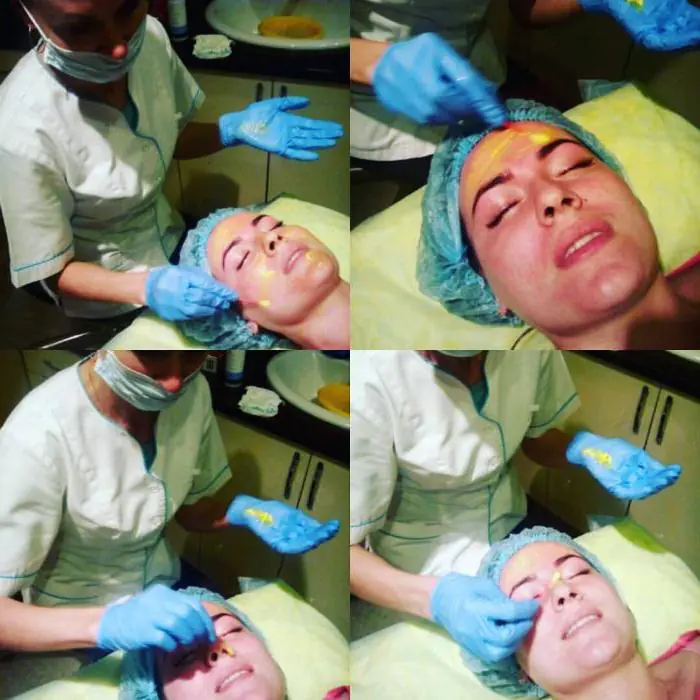
Peeling is called yellow, because after applying the composition to the surface of the facial skin, it acquires a yellowish tint. There is no need to be afraid of such an effect, because it is only a temporary phenomenon. The procedure is called retinol or retinoic peeling in connection with the main active component of the product - retinoic acid.
Experienced cosmetologists often call peeling a weekend procedure. It received this name due to the fact that patients will need exactly two days to recover. Experts strongly recommend going for a session on Friday so that by Monday your skin will be completely back to normal.
Expected Result
Most often, reviews from cosmetologists about retinoic peeling indicate that after the procedure the patient’s face looks much better. Thanks to the retinoids included in the composition, the following changes occur:
- wrinkles become less noticeable;
- blood circulation improves;
- the skin is cleansed of bacteria;
- the humidity level is normalized;
- a healthy glow appears.
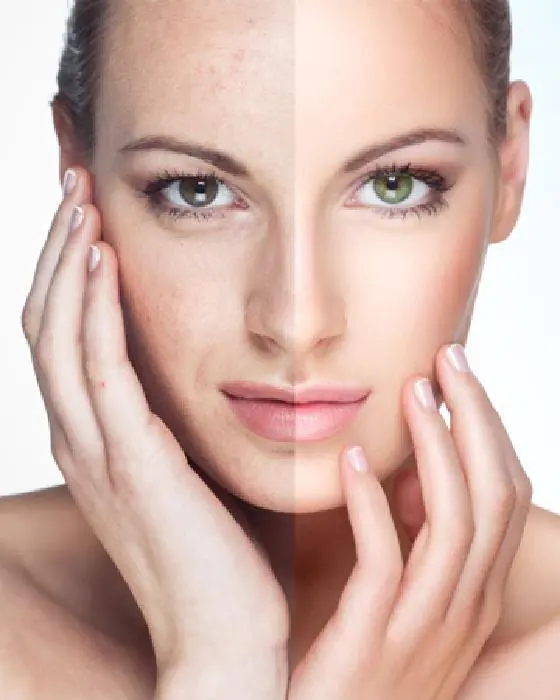
You can achieve these results quite easily, because a couple of sessions will be enough for this. The break between them should be exactly one and a half months. It is worth noting that the final result directly depends on the initial condition and characteristics of the skin.
The peeling contains various acids, each of which has its own unique properties:
- phytic acid is designed to fight emerging inflammatory processes;
- Koyaeva is able to destroy dead cells and reduce melanin levels;
- ascorbic acid (vitamin C) helps slow down the aging of the skin;
- azelaic acid perfectly regulates the functioning of the sebaceous glands, eliminates age spots and acne.
Who needs peeling?
The procedure is intended for those with mature skin. It is for this reason that older women most often leave reviews about retinoic peeling. Photos before and after the session make it clear that the procedure is truly effective and worthy of attention.
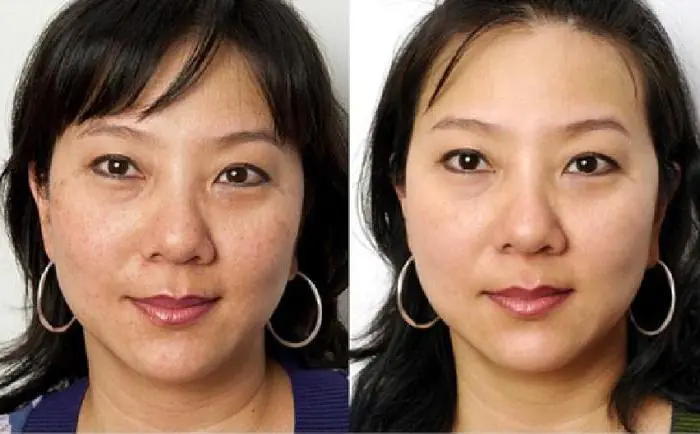
As a rule, patients aged 35-50 years turn to peeling. For younger women, the procedure will be useful in the following cases:
- overly rich and bright pigmentation;
- many pimples and blackheads;
- too strong activity of the sebaceous glands;
- pronounced acne scars;
- first destructive skin changes;
- skin diseases.
Advantages
Due to the large number of advantages, people most often leave positive reviews about retinoic peeling. The before and after photos presented in the article are a good example of how incredible results can be achieved.
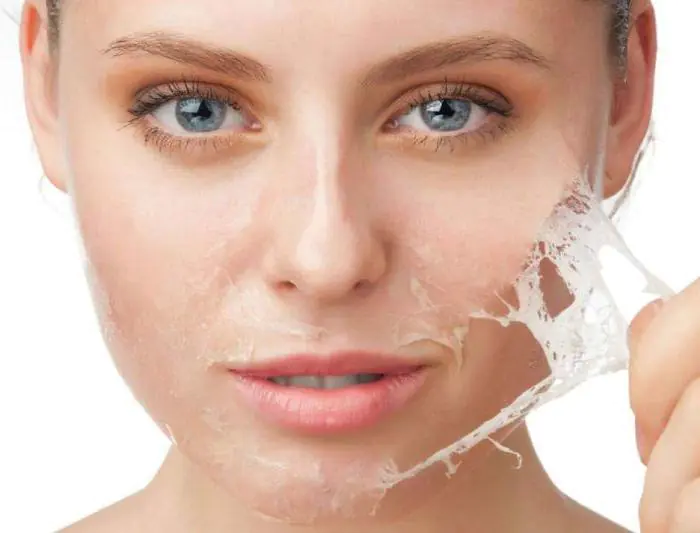
The main advantages of peeling include:
- Safety. In its component composition, retinoic acid is similar to vitamin A. Based on this, there is no need to worry about the human body’s reaction to it. The mixture also contains some other acids that can enhance the effect of retinoic acid, which is the active ingredient.
- Delicate impact. Yellow peeling is rightfully considered one of the most gentle, so there are no obstacles to achieving noticeable results.
- Efficiency. Most specialists begin rejuvenating the skin of their patients with this procedure. In some cases, the effect of a couple of sessions is equal to 10 procedures with glycolic acid. The resulting effect lasts quite a long time – up to 4 months.
- Fast recovery. The face after retinoic peeling, of course, will peel and turn red, but all these problems go away very quickly. For final restoration of the skin, no more than two days are needed.
Preparing for the session
Before skin rejuvenation, certain preparation for retinoic peeling is required. First of all, the specialist determines the type and condition of the skin, the tendency to allergies, as well as the presence of various ailments that may interfere with peeling. Immediately after this, the client is prescribed certain creams, which must be used for several weeks in a row. Most often, these products are based on glycolic acid. Thanks to them, the skin softens, which allows retinoids to easily penetrate to a greater depth. In the absence of proper preparation, the effect of the procedure may be several times less.
Retinol peeling requires avoiding tanning salons, using exfoliants, and long-term sun exposure. During the week before the procedure itself, you should remove yourself from all this so as not to damage the skin.
Carrying out the procedure
The first thing you need to do is cleanse your face of decorative cosmetics. Immediately after this, the skin is treated with a solution consisting of salicylic and glycolic acids. This helps remove dead cells. As soon as the solution begins to interact with the skin, it is cleansed. During this, the client may feel a slight burning sensation, which will go away in just 4-7 minutes.
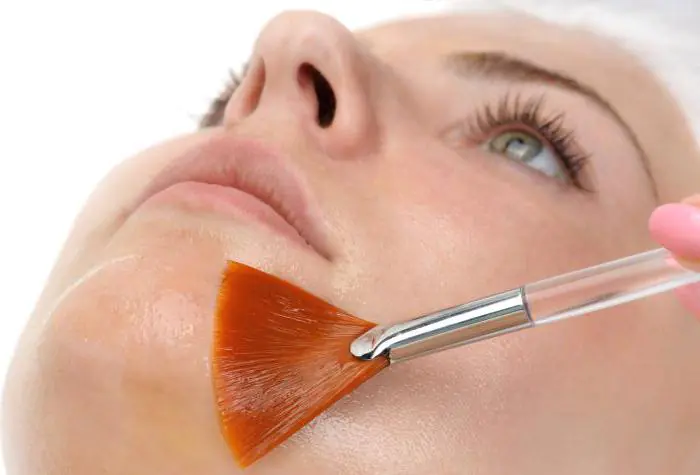
The next step is to apply the composition to the face. This mask can be kept on from 15 minutes to as long as 12 hours. The holding time is determined based on the desired result. After this, the product is thoroughly washed off under running water, and then a protective cream is applied to the skin and evenly distributed.
Consequences and contraindications
Contraindications and complications of retinoic peeling are of interest to all people who decide to undergo such a procedure for the first time. In this case, everything happens as usual: slight redness, itching, peeling and swelling appear. All this goes away quite quickly, so you will be able to enjoy the results very soon.
Complications after the procedure can only arise if it was performed with a low-quality composition or in the absence of proper preparation. Skin irritation or inflammation may occur. If they do not go away on their own for a long time, then you should definitely contact a specialist as soon as possible.
Peeling is not recommended for pregnant women or nursing mothers. In addition, cosmetologists prohibit performing the procedure for people who have:
- recent tanning;
- allergic reaction to vitamin C;
- active herpes;
- damage to the skin to which the composition must be applied;
- severe illness;
- individual intolerance to certain components.
Such people can replace the retinoic procedure with laser or ultrasound peeling. They also have the opportunity to turn to diamond microdermabrasion.
Skin care after peeling
The rehabilitation period does not last that long, but during this time it is necessary to take proper care after retinoic peeling. As you know, during recovery you feel severe dryness and tightness of the skin. After some time, a crust appears on the surface of the face, which under no circumstances should be removed. After a few hours it will go away on its own; if it is disturbed, complications may arise. Many reviews about retinoic peeling (photos before and after are below) say that when the crust is peeled off, scars, pimples, and age spots appear, which are not as easy to get rid of as it seems at first glance. Therefore, women who have already dealt with a similar problem are strongly recommended not to touch this layer.
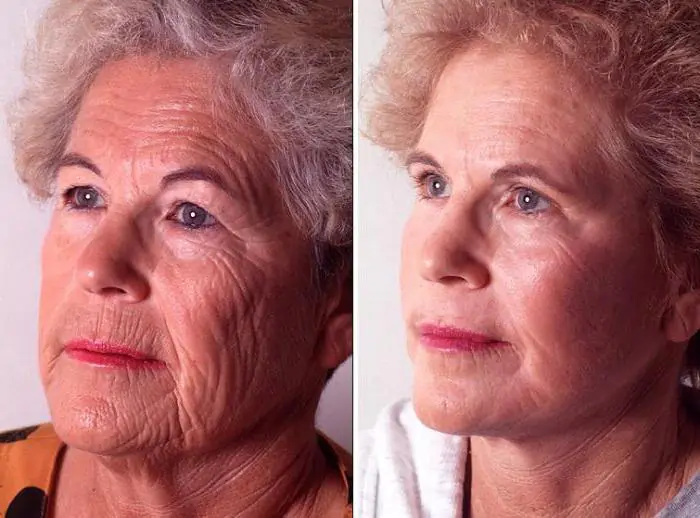
During rehabilitation, it is necessary to regularly use special means. They are prescribed by the specialist who performed the procedure, because he knows all the characteristics of his patients’ skin, and can also determine which products will help restore and not worsen the condition of the skin. When going for a walk under the scorching sun, you need to wear a classic wide-brimmed hat that will cover your face from the direct rays of the sun. In addition, you should first apply sunscreen to your face, thereby protecting yourself from the adverse effects of ultraviolet rays, which pose a particular danger during recovery.
Retinoic peeling itself is a safe procedure. In isolated cases, after a session, patients experience increased acne, which can only be treated by an experienced specialist. This side effect doesn't just happen. The main reasons are neglect of personal hygiene or contraindications. Therefore, in order to protect yourself from such consequences, you need to properly care for your facial skin not only after each procedure, but also use regular moisturizing and cleansing creams, lotions and other cosmetics daily.
Cost of the procedure
For people interested in skin rejuvenation, the price of retinoic peeling becomes relevant. Today, specialists in various salons perform the procedure for only 4-6 thousand rubles per session. For those with normal skin, for which two sessions are enough, paying for peeling will not be difficult. But those who require a course of treatment consisting of 4 procedures will have to spend a considerable amount of money.
The price of retinoic peeling is acceptable to many clients. For this money they get an incredible effect that they cannot achieve on their own.
Peeling with retinoic ointment at home
Conventional drugs containing retinoic acid are freely sold in pharmacies. You can buy them without a prescription. That is, buying a special ointment and using it at home will not be difficult.
The recipe for retinoic peeling at home is quite simple. To carry out the procedure yourself, you need to stock up on the following components:
- moisturizing cream;
- retinoic ointment;
- a tablespoon of water;
- glycolic cream;
- teaspoon of soda.
Many people are interested in how to do retinoic peeling at home, because this procedure will be several times cheaper than in a salon. In fact, there is nothing complicated about it. It is performed in several steps:
- cleansing the face of decorative cosmetics and wiping with a paper towel;
- applying and evenly distributing cream with glycolic acid over the surface of the face;
- skin treatment with a retinoic agent;
- applying a neutralizing mixture consisting of soda and water (45 minutes after the ointment);
- after 7 hours, rinse off the composition with warm water;
- moisturize the skin with regular cream.
As mentioned above, a slight burning sensation may be felt on the skin during the procedure. There is no cause for concern, since such a reaction only means that the composition reacts with the skin and the beginning of the process of cleansing and rejuvenation.
Immediately after the session, peeling begins. When performing peeling at home, it can last a little more than two days, but no more than a week. Under no circumstances should you manually assist natural exfoliation. This nuance must be taken into account, as there is a risk of damaging the skin. The best way to combat peeling during this period is frequent moisturizing with special products.
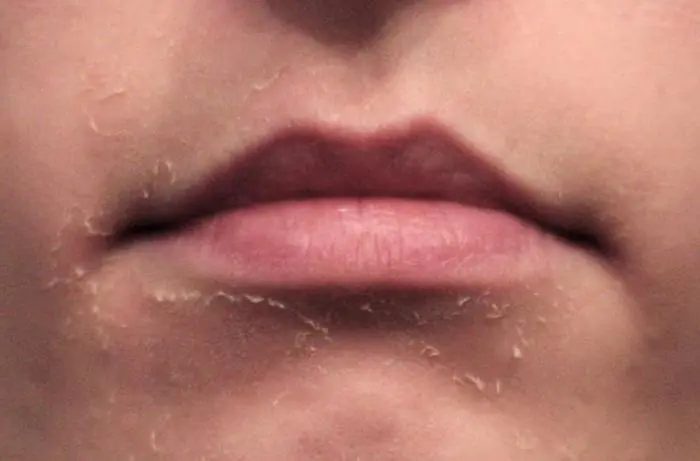
In the first days after peeling, redness will appear. They can only last a day or two. The skin will completely heal and recover within a week after the session.
You can secure a long-lasting effect by repeating the cleansing three times. That is, it is necessary to carry out the procedure once every three weeks, and then repeat the procedure again after six months.
Reviews
The opinion of patients regarding retinoic (yellow) peeling most often boils down to the fact that it is as effective and painless as possible. Many women who decide to undergo the procedure like to conduct various experiments with their skin without fear of an unpleasant result. After the peeling, they experienced only enthusiastic emotions, since they simply did not expect such an amazing effect.
Despite the cost of the session, which may seem high to some people, patients do not mind paying that kind of money for a peeling that will lift their spirits for a long time. Due to the fact that the procedure copes with several problems simultaneously, women are happy to turn to it and do not regret it in the future.
It is almost impossible to encounter negative reviews about it, since everyone is happy with the result obtained and has nothing against the means used to achieve it. Only a small part of women indicate some negative aspects in their reviews. The most common of these is a burning sensation felt during cleansing. At the same time, some people are unhappy that after the procedure they have to refrain from direct sunlight, which is quite difficult to do in the summer season.
In order to see your face looking young and radiant after peeling, you must adhere to certain skin care rules. As a rule, a cosmetologist gives a list of advice to a woman after the exfoliation procedure. These requirements are mandatory.
Some women believe that by choosing an experienced cosmetologist and paying a considerable amount for exfoliation, they are guaranteed to get a good result. Of course, the success of the procedure depends on the professionalism of the salon master. But the result is greatly influenced by how correctly the rehabilitation was carried out. Even the impeccable work of a cosmetologist can be nullified by incorrect post-peeling care.
What happens to facial skin after peeling?
The salon master often has to answer questions from clients: is it possible to sunbathe, go to the bathhouse, or make nourishing masks after facial peeling? In order for a woman to understand what to do after exfoliation and what to watch out for, she should understand the nature of exfoliation.
Exposure to chemical compounds, devices, and lasers causes injury to the skin. The damaged epidermis begins to launch the regeneration process. In place of dead exfoliated cells, young ones are formed, collagen and elastin are intensively released. As a result, the dermis is transformed in place of scars, wrinkles, age spots and young, elastic, healthy skin is formed. The most important thing at this moment is to carry out proper rehabilitation of the skin or restoration of the epidermis after peeling.
Exfoliation comes in different types depending on the method and depth of impact, but the principle of action is that the skin is exfoliated. Immediately after peeling, you should not wash your face for 24 hours, as there is a high risk of infection and complications. In addition, tap water contains chlorine, which can irritate the epidermis.
After 2-3 days, a feeling of tightness appears on the face, and then the skin after peeling is removed with a film. At this moment, crusts form on the face, which is a normal physiological stage of skin healing after a burn or injury. Under this hard layer, young epidermal cells are actively formed. Touching the face or removing scales is strictly prohibited. Independently removing crusts and films from the face with your hands or using scrubs can result in scars. They will be much more difficult to remove.
What should you not do after peeling?
There are certain recommendations from cosmetologists about what not to do after facial peeling:
- You should not wash your face with water for the first 24 hours after exfoliation. After 2-3 days, you can wash your face with boiled warm water. After a few days, it is recommended to use mild cleansers that do not contain abrasive particles;
- The use of cosmetics and decorative cosmetics is also not allowed. Foundation, powder, blush, bronzer or highlighter can become a source of infection and clog pores. In addition, makeup applied to flaky skin looks unaesthetic;
- visiting a bathhouse, experiencing stress, eating spicy foods, and drinking alcoholic beverages is not recommended. All these actions lead to dilation of blood vessels and prolong the period of hyperemia (redness of the face);
- Do not engage in active sports, as this promotes increased sweating. Drops of sweat contain salts and irritate the epidermis, and are also a favorable environment for the development of infection;
- Trying new brands of cosmetics is not recommended, as the skin's reaction to them can be unpredictable. The cosmetologist will tell you what products and preparations need to be used after superficial or other peeling;
- Do not self-medicate if complications or adverse reactions occur. In this case, you need to contact a cosmetologist or dermatologist;
- Do not expose your skin to the risk of infection: touch it with your hands, visit the pool, swim in natural bodies of water;
- stay in direct sunlight for a long time, walk in windy, rainy or frosty weather.
Features of facial care after certain procedures
Each type of exfoliation has its own characteristics. The effect on the epidermis is carried out in various ways and with varying degrees of intensity. Restoring the skin after peeling of one type or another requires special care. The more intense the impact was directed at the epidermis, the more serious the injury. For example, with deep exfoliation, almost all layers of the skin are exfoliated, leaving only a thin layer of tissue. Rehabilitation after such peeling will be the longest.
Superficial peeling
Superficial exfoliation affects only the upper layers of the epidermis. With this procedure, you can eliminate the problem of acne, fine wrinkles, and give your face a fresh, healthy look. In this case, the skin receives minimal trauma and is restored in the shortest possible time, up to 10 days. The main rule of rehabilitation after superficial peeling is to exclude contact with water for 1-2 days. During this time, the face will turn red. The woman has a feeling of tightness.
The next day, the skin begins to actively peel off and this is a normal reaction to exposure to abrasives and chemicals. On the 3rd day after peeling, you can wash your face with boiled water. As a cleanser, you should choose delicate foams and gels without abrasive particles, fragrances and dyes. You can use an ointment with a wound healing effect, for example Panthenol. Do not peel off crusts that may form on the face with your hands or otherwise peel them off. They should come off on their own.
Please note: when applied to the epidermis, Panthenol may sting a little. The skin after exfoliation is especially sensitive to any influences.
Don't forget about sunscreen cosmetics that will protect against the appearance of age spots.
Medium peeling
The medial type of exfoliation affects the deeper layers of the epidermis down to the basement membrane, therefore, the skin suffers serious damage. The most popular are retina peeling, dermabrasion and laser exfoliation. After these manipulations, a 2-week facial rehabilitation takes place. During the rehabilitation period after medium-type chemical peeling, the layers of the epidermis are restored, the skin becomes young, elastic, wrinkles are smoothed out, scars and cicatrices become less pronounced.
In addition to the basic recommendations of cosmetologists, there are a number of tips that should be followed. After a medium chemical peel, do not wash your face for 48 hours. On the 3rd day you can wash your face with boiled water.
During the process of medial exfoliation, the deep layers of the epidermis are exfoliated. Therefore, facial rehabilitation after retinoic peeling is often accompanied by swelling, redness, and inflammation of the face. Normally they should disappear after 2 weeks.
Attention! If swelling, inflammation, and redness of the face are excessive and do not disappear after 14 days, you must consult a cosmetologist or dermatologist.
During the rehabilitation process, it is allowed to use ointment with panthenol, complementing it with facial care cosmetics prescribed by the salon master.
A day after exfoliation, peeling of the face occurs, which can last up to 1.5 weeks. You can’t tear it off to avoid scars and scars.
Before going outside, even in cloudy weather, apply sunscreen.
Deep peeling
Effective procedures such as TCA peel and phenol exfoliation are deep exfoliation. Thanks to these cosmetic procedures, you can significantly rejuvenate the skin and eliminate serious defects. In this case, the skin is seriously injured. The deep exfoliation procedure is performed under anesthesia, and rehabilitation takes place in a hospital setting. Many women are interested in: why can’t you wash your face after a TCA peel? After deep peeling, only a thin layer of cells remains from a woman’s skin, which require minimal intervention for restoration. Water can become a source of infection or a breeding ground for microbes. Inflammation is fraught with deep scars and scars. Therefore, contact with water should be avoided for up to 4 days. It is even recommended to drink water through a straw.
Rehabilitation takes a long period of up to 2 months. At this time, the doctor prescribes antiviral drugs, vitamins and special cosmetics. If a TCA peel has been performed, you should not self-medicate or take unauthorized medications.
The skin may darken after a deep exfoliation procedure, but this defect disappears over time. During the recovery period, and then constantly, it is necessary to apply sunscreen to your face.
Recommendations from cosmetologists
If you follow the care recommendations described above, there should be no adverse reactions or complications after exfoliation. An experienced cosmetologist will definitely share a couple of secrets with the client. They will help restore your face after peeling in the shortest possible time and consolidate the result for a long time. Here are some important recommendations from cosmetologists:
- peeling of the skin is normalized by moisturizers based on hyaluronic acid with the addition of shea butter or grape seed;
- In order for facial redness to go away faster, you need to adjust your diet by eliminating spicy, pickled foods, alcohol, and also adding foods with omega-3 acids;
- Edema will be eliminated by products containing antioxidants, as well as decongestant ointments prescribed by a doctor;
- Acne is not a normal reaction of the body to exfoliation. You need specialist consultation and adequate treatment;
- allergies may occur if exfoliation was carried out without a preliminary allergy test. The doctor prescribes an antihistamine.
- Increased formation of age spots is a consequence of an unsuccessful time of year for the procedure or ignoring the application of products with SPF. If you still have pigmentation, you should pay a visit to a cosmetologist. He will look at how the skin has recovered, whether there are any adverse reactions, and prescribe the necessary procedure.
Summary
Peeling is a wonderful way to “erase” almost all imperfections from a woman’s face. But, unfortunately, the success of the procedure depends not only on the qualifications of the cosmetologist. It is very important for a woman to follow all the advice of the salon specialist. Then unpleasant consequences and complications will bypass you, and your skin will glow with youth and health.
We'll tell you what retinoic peeling is, what makes it unique, why it's called yellow, and why those who are under eighteen love it.
- What is retinoic peeling
- Types of retinoic peeling for the face
- How is peeling done?
- How to care for your skin after a retinoic peel
- Precautionary measures
- Tips and reviews from cosmetologists
What is retinoic peeling
Like any peeling, retinoic peeling is aimed at renewing the skin and improving the appearance of the skin. But it has a number of features that fundamentally distinguish it from its “colleagues”, be it acid, mechanical or hardware versions of peeling. What is its unusualness and why is it called “peeling from the inside”?
Composition and mechanism of action
The main component is retinoic acid. It stimulates the growth and proliferation of keratinocytes, accelerates cellular renewal. It also turns the product yellow. To make it easier to understand how retinoids work with skin cells, let's compare them with their main competitors - fruit acids, for example, glycolic acid. Its goal is to damage the stratum corneum of the skin, resulting in the exfoliation of old cells and their replacement with new ones. Retinoids act differently: they do not destroy anything, moreover, they do not work directly at all either with the cells of the stratum corneum or with intercellular structures.
Retinoic peel is a yellow mask © Getty Images
The target of retinoids is not the surface of the epidermis, but the deeper basal layer in which cells originate. Being small lipophilic molecules, retinoids easily reach their destination and significantly accelerate the division of keratinocytes, or, more simply, the formation of new cells. Young keratinocytes en masse begin to move upward, to the surface of the skin, and literally push out the overlying layers. Hence the effect of exfoliation and renewal.
Retinoic peeling does not destroy dead structures, but stimulates living ones by contacting cell nuclei through special receptors. Moreover, retinoic acid interacts not only with keratinocytes, but also with fibroblasts and melanocytes, improving the condition of the skin in several indicators, including density, elasticity and uniformity of pigmentation.
In addition to retinoic acid itself, the peeling preparation includes auxiliary components, mainly acids, that can enhance one or another cosmetic effect. For example:
whitening: Fetinic, kojic, azeloic acids;
exfoliation: salicylic acid;
fight against free radicals: vitamin C;
calming and anti-stress effect: allantoin, aloe and chamomile extracts.
Indications for use: who will need it and when?
The abilities of retinoic peeling are multifaceted. In addition to standard indications for peelings, including dullness, increased greasiness, uneven surface, retinoic acid works with age-related skin changes, such as:
thickening of the stratum corneum.
Therefore, the majority of fans of retinoic peeling are women who have crossed the forty-year mark.
Skin with acne (not in the inflammatory stage!) and post-acne phenomena also respond well to the effects of retinoids.
Efficiency
Like any peeling, retinoic peeling is done in a course. Although the result in the form of fresh, renewed, radiant, smooth skin can be noticed after the first session. The final effect depends on the number of procedures, the concentration of the chemical agent, and the peeling application regimen. As a result, you can achieve:
smoothing superficial wrinkles and reducing deep ones;
lightening or complete disappearance of age spots;
even out skin texture and tone;
skin tightening and light lifting.
How often can you do it
Types of retinoic peeling for the face
Among cosmetologists and patients, retinoic peeling is known as “Yellow Peel”. The fact is that retinoic acid, like all synthetic analogues of vitamin A, has a bright yellow or orange color - hence the name.
The composition of the peel and the concentration of the main substance vary depending on the specific preparation and manufacturer. Typically, professional Yellow Peel contains 5-10% retinoic acid.
Retinoic acid gives the peel its yellow color © Getty Images
As for the usual classification of peelings (superficial, medium, deep), in the case of retinoids it is very arbitrary. Strictly speaking, retinoic peeling cannot be superficial, since it only works in the deep basal layer of the epidermis. However, with Yellow Peel you can achieve:
medium and medium-deep peeling, renewing all layers of the epidermis.
There is a type of retinoic peeling that works only to tighten the skin turgor and does not cause peeling at all.
How is peeling done?
Preparation
Two weeks before the “yellow peeling”, start using products with acids in your home care. This will help your skin clear the way for retinoids to penetrate into the deeper layers. Usually, special cosmetics are recommended by a cosmetologist. We provide examples of products that meet the requirements of pre-peeling preparation.
Two-stage peeling Visionnaire Crescendo, Lancôme consists of two parts, each of which is designed for two weeks of use. The first phase, just the preparatory phase, includes a low concentration of fruit acids and quinoa husk extract. These substances provide easy exfoliation and accustom the skin to the active action of peeling agents.
Cleansing toner for mature skin against imperfections Blemish & Age Solution, SkinCeuticals Suitable for preparing skin for salon peeling. Contains glycolic, salicylic and capryloyl-salicylic acids for gradual gentle exfoliation.
Night peeling that activates skin radiance, Idéalia, Vichy The formula contains glycolic acid 4% + Hepes 5%, as well as antioxidant blueberry extract. Renews skin and enhances its radiance with fermented black tea extract.
Carrying out the procedure
Before applying the yellow peel, the skin is cleansed and treated with an acid-based lotion to loosen the stratum corneum and facilitate the penetration of retinoic acid.
The peeling itself is a yellow cream mask, which is applied in a thin layer to the entire face (including the skin around the eyes) or to individual areas using rubbing movements. This ends the mandatory stages of the protocol - further options are possible.
Peeling can be tolerated on the face 15-20 minutes, and then rinse with a solution with neutral pH.
Maybe repeated (and repeated) application and rinsing of retinoic peeling during one session.
Another option: leave the mask on for six hours, and then the “yellow-faced” patient goes home and washes off the composition on his own.
The procedure is painless, the maximum discomfort is a slight tingling sensation and a feeling of warmth.
Retinoic peeling solves the problems of aging and young skin © Getty Images
How to care for your skin after a retinoic peel
The rehabilitation period after a procedure with a moderate effect (that is, causing active peeling and renewal of the skin) takes an average of a week.
A feeling of tightness occurs on the 2nd day.
Peeling begins on the 4th day after peeling.
Please note: superficial peeling does not cause discomfort and violent peeling, but the effect of such peeling is less expressive.
During the post-peeling period, you will need cosmetics that meet special requirements. The main one is the complete absence of acids in the composition.
Rules for skin care after peeling
Washing with gel-like products that do not contain aggressive surfactants and oils. Our recommendation - cleaning micellar gel for face and eyelids Rosaliac Gel, La Roche-Posay, , which contains hyaluronic acid in its composition, provides comfort and freshness when washing.
Care including products with the function of protecting and restoring the skin barrier. They need to be applied several times a day for 3–5 days after peeling.
Mandatory sun protection with maximum SPF.
We recommend a restorative soothing agent La Roche-Posay - Cicaplast balm SPF 50 with madecassoside for better skin regeneration and panthenol for a calming effect and restoration of the protective mantle. The solar screen and the prokerad component provide prevention of post-peeling pigmentation.
Precautionary measures
Yellow peeling reduces the skin's immunity, making it susceptible to infections. Often, an exacerbation of herpes occurs as a side effect. Usually cosmetologists prescribe special medications before peeling to prevent this reaction.
Retinoids in high concentrations cause large-plate peeling. Plus, the manifestation of retinoic dermatitis in certain areas of the skin is considered normal, which manifests itself:
Usually these troubles go away on their own after the rehabilitation period.
Tips and reviews from cosmetologists
Medical Expert Vichy Elena Eliseeva believes: “Retinoic peeling is a safe and effective procedure.” Below we list its main advantages.
Relatively fast recovery period. Cosmetologists often call it a weekend procedure: if you peel on Friday, your face will return to normal by Monday.
Retinoic peeling is optimal not only for general skin renewal and rejuvenation, but also for targeted correction of hyperpigmentation.
It is carried out in a shorter course, on average 4–5 procedures are enough.
This procedure is contraindicated during pregnancy and lactation; for liver diseases; during the season of active ultraviolet radiation (and in the case of already developed tanning). Contraindications also include damage to the epidermis (due to dermatological diseases or as a result of banal squeezing of pimples).



